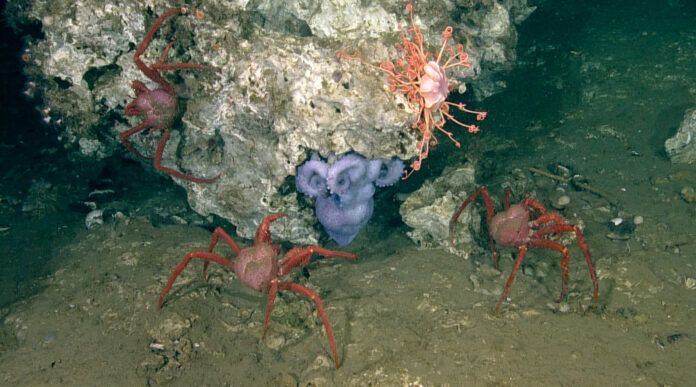Watching an octopus defend her eggs while battling giant king crabs is highlighting a need to protect ecosystems in areas most people do not often see.
That’s from two DFO researchers, Heidi Gartner and Dr. Cherisse Du Preez who were recently out on an expedition near Hesquiaht, off the west coast of the Island.
The expedition was to research deep sea habitats and biodiversity for conservation, in cooperation with Fisheries and Oceans Canada, the council of the Haida Nation, Nuu-chah-nulth Tribal Council, Pacheedaht First Nation, and Ocean Networks Canada.
According to Gartner, the area called Hesquiaht Slope has methane gas that seeps out of the ocean floor. This creates an abundance of life in a deep-sea ecosystem, carbonate rock and habitat for one animal in question.
“What we were finding at this one site that was absolutely incredible is that a lot of octopuses were using this habitat to brood their eggs,” said Gartner. “So, we found over a dozen, probably two dozen if not more and this was in a very small area that we looked at.”
The octopuses are the deep-sea octopus, which according to Gartner, are purple-coloured cephalopods that requires these types of habitats to brood their eggs. Du Preez adds they are much smaller than the giant pacific octopus, with black eyes and shorter arms.
“It kind of looks a little cartoony and its arms are often muddy because they do this really cool feeding technique of walking along the muddy abyss and then they jab their arms into the mud to try and find their meals,” said Du Preez.
Gartner adds they are also a long-lived octopus, and they spend around four years caring for their young.
“There’s no evidence that female octopuses eat, move or do anything during the period where they’re caring for their eggs,” said Gartner.
While diving, they came across one octopus who was likely near the end of its breeding period and that was evident because of pressure from king crabs trying to get some food.
“You can see the eggs look quite developed, you can see eyes of the babies in the eggs, and she actually looks like what we call emaciated,” said Gartner. “Her skin is hanging off; her colour isn’t as bright.”
Despite the king crabs reaching out and snipping at the octopus, Du Preez says the octopus was winding up to “punch” the crabs away and protect her young and that appears to have been a success.
“After we had done some experiments, we came back to check up on her again and she had actually successfully fended off those crabs, so it was a really good ending to our time with her,” said Du Preez.
While the team was diving to research the surrounding area, they say experiences like these allow them to share the need to protect these areas with others.
“It is absolutely breathtaking when you get an opportunity to see something that most people don’t get to see and to watch these lifecycles of animals that are very poorly understood or studied because the deep sea is so hard to get to,” said Gartner.
“It’s a very important moment as a conservation person who’s trying to connect those people on shore with these habitats and a lot of people can relate to this idea of a mama protecting her eggs and living down there and facing challenges just like the rest of us do.”
Du Preez adds that when it comes to protecting biodiversity on the planet, humans are a minority compared to all the other animals in the world and hopes we can get to know these animals better through footage like this.






